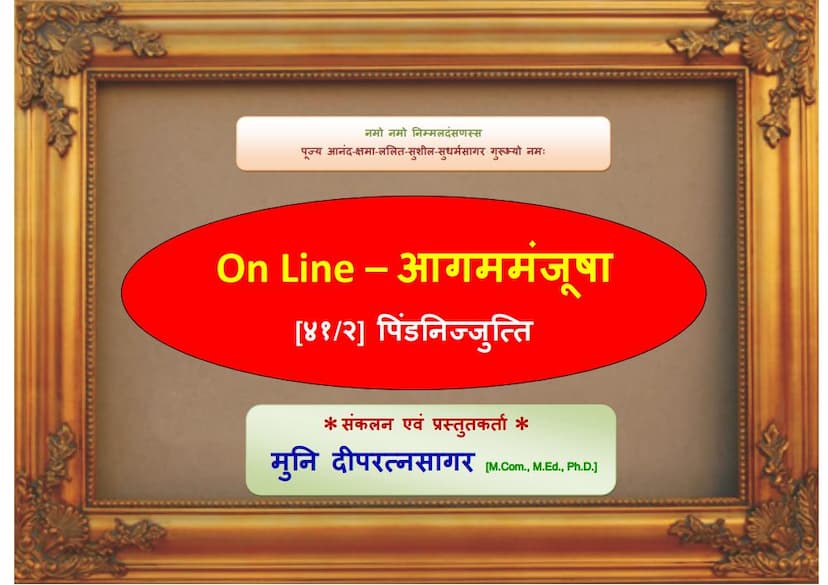Aagam Manjusha 41B Mulsuttam Mool 02 B PindaNijjutti
Added to library: September 1, 2025

Summary
Here is a comprehensive summary of the Jain text "Aagam Manjusha 41B Mulsuttam Mool 02 B PindaNijjutti" in English:
This text is a commentary or explanation of the Pindaniryukti, a foundational Jain scripture. The introductory sections mention that this work is part of the "Agam Manjusha" series, which was originally edited by Acharya Shri Anandsagarji in 1942. The current online version is an updated presentation of this work, released in 2012, with some modifications to include commentaries and other relevant texts that might have been presented differently in the original compilation. The publishers are Deepratnasagar.
The core of the text, the Pindaniryukti, deals with various classifications and principles related to Jain practice and doctrine, primarily focusing on the concept of "pinda" which can refer to a collection, a lump, or even a holistic system. The text systematically breaks down these concepts through verses and explanations.
Key Themes and Concepts Covered:
- Classification of "Pinda": The text begins by defining "pinda" in a broad sense, encompassing different aspects like origin, method of obtaining, union, measure, cause, and smoke. It further categorizes "pinda" into groups, accumulation, joining, collection, and piles.
- Nixkhepa (Classification/Disposition): A significant portion of the text is dedicated to the nixkhepa of "pinda." It explains that "pinda" can be classified into four, six, or even more categories. The text emphasizes that after classification, a detailed explanation should follow.
- Six Types of Nixkhepa: This includes nama (name), sthāpanā (placement/representation), dravya (substance), kṣetra (space/region), kāla (time), and bhāva (state/attitude).
- Nama-pinda (Name Pinda): This refers to names assigned to things, either created by convention (samayakṛta) or through mutual understanding (ubhayakṛta). Examples given are names associated with deities or specific individuals.
- Sthāpanā-pinda (Representation Pinda): This relates to the symbolic representation of things, whether through art, carvings, or abstract concepts. It acknowledges that representation can be based on actual resemblance or on conventional understanding.
- Dravya-pinda (Substance Pinda): This section meticulously classifies substances into:
- Living (Sachitta): Substances containing life-force.
- Non-living (Achitta): Substances devoid of life-force.
- Mixed (Mishra): Substances containing both living and non-living elements.
- Each of these categories is further divided into nine sub-categories based on the elements of earth, water, fire, air, plants, and the various types of beings (two-sensed, three-sensed, four-sensed, and five-sensed).
- Detailed discussions are provided on the specific rules and exceptions for the usage and handling of these categories, especially concerning the concept of prachinna (cut) and prachinna (uncut) with respect to various substances like water, wood, and grains. The text delves into specific rules for cleaning, usage, and potential contaminations, particularly relevant for ascetics.
- Bhava-pinda (Attitudinal Pinda): This refers to the internal states and attitudes of an individual.
- Pashastha (Proper/Virtuous): These are commendable attitudes and practices like faith, knowledge, conduct, penance, vows, asking for alms, accepting vows, following the teachings of the Jinas, and the path of righteousness.
- Apashastha (Improper/Vicious): These include negative attitudes like uncontrolled desires, passions, ignorance, anger, pride, deceit, greed, and lack of proper conduct.
- The text explains how actions and karma are bound by these bhāvas, with virtuous states leading to liberation and vicious states leading to further entanglement.
- Eshanā (Seeking/Alms-seeking): A significant portion of the text is dedicated to eshanā, which refers to the rules and principles governing the seeking of alms and resources by Jain ascetics. This is a crucial aspect of monastic life, ensuring purity and non-violence in sustenance.
- Types of Eshanā: This includes nāma (name-based seeking), sthāpanā (representation-based seeking), dravya (substance-based seeking), and bhāva (attitude-based seeking).
- Detailed explanations are given for each type, illustrating them with examples from various contexts, including seeking from different types of beings, specific food items, and situations.
- The text also discusses ugama (origin), upāyana (method), and mārgṇā (search) in relation to eshanā.
- Specific Rules and Prohibitions: Throughout the text, there are numerous specific rules and prohibitions related to the usage of food items, utensils, water, and other necessities. These rules are often based on avoiding attachment, violence (himsa), and maintaining purity of body and mind.
- Contamination (Pūjī): The text elaborates on what constitutes contamination in various substances and situations, and the procedures for purification or avoidance.
- Prohibited Actions (Dosa): Many actions are described as faults or violations (dosa) of ascetic principles, such as improper seeking, improper usage of resources, and inappropriate interactions.
- Karma and Liberation: The underlying theme is that adherence to these rules helps in purifying karma and progressing towards liberation (moksha).
- Examples and Analogies: The text uses numerous analogies and examples from daily life, nature, and the lives of saints and kings to illustrate complex principles. These help in understanding abstract concepts like pinda classification, contamination, and the consequences of actions.
- The Nature of Karma: The text touches upon how karma is acquired through various actions, intentions, and associations, and how adherence to the prescribed conduct helps in shedding or purifying this karma.
- Purity in Alms-Seeking: The emphasis is consistently on seeking alms in a pure manner, avoiding any form of harm or attachment. This includes understanding the nature of the food, the vessel, the giver, and the method of receiving.
Overall Purpose:
The Pindaniryukti as presented in this compilation serves as a guide for Jain ascetics and practitioners, providing a detailed framework for maintaining purity, non-violence, and detachment in their daily lives and spiritual practices. It emphasizes the importance of understanding the subtle nuances of various actions and substances to avoid karmic accumulation and progress on the path to spiritual liberation. The text highlights the meticulous nature of Jain monastic discipline, where every aspect of life, from food intake to the handling of minimal possessions, is governed by precise rules aimed at spiritual purification.